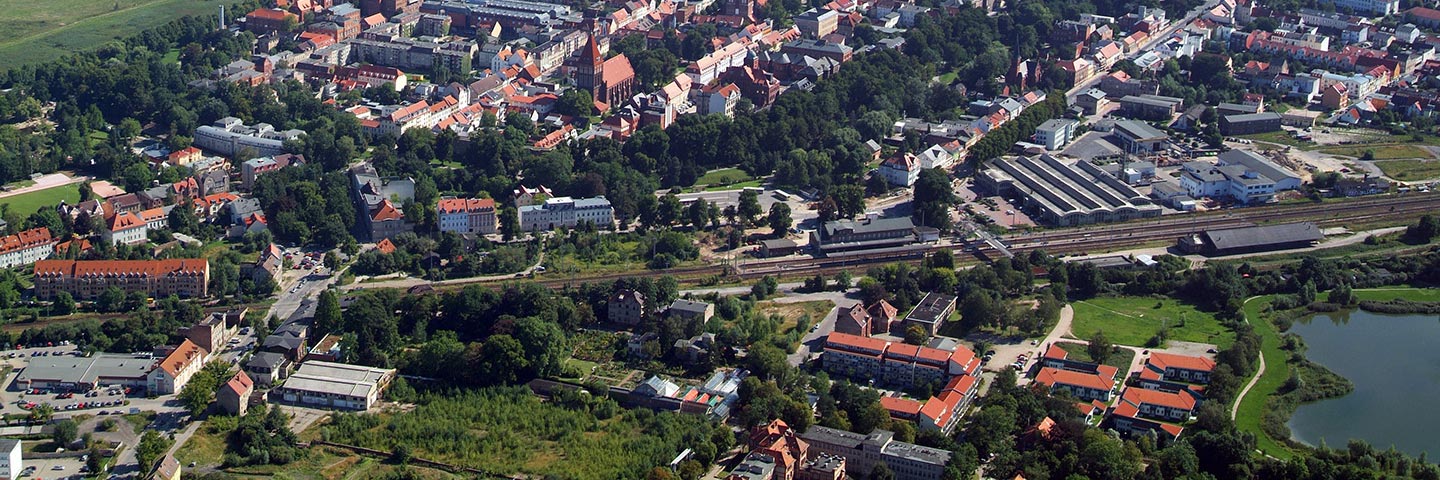News
2022
by NK
Paludiculture: How to and with what plants?
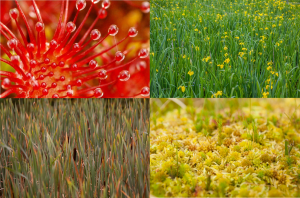
Two new GMC publications show it
20/12/2022 You happen to have a peatland where you want to implement paludiculture, but don't know how? Convert an entire farm to "wet" agriculture - how can that be done? Or - you might be looking for the biomass from wet land for new products? For questions like these, the new Guide to Implementing Paludiculture (German only) within the GMC proceedings offers information. It aims at land managers, landowners, project sponsors, water and soil associations, government agencies, agricultural advisors, research institutions, and potential utilization companies. The guide covers five areas: Site suitability, planning and permitting for conversting sites to paludiculture, practical tips for establishment and management of sites, as well as utilisation of the biomass produced and support - including examples of implementation.
The publication Potential Paludiculture Plants of the Holarctic (English only) presents which plants are suitable for paludiculture in the Holarctic. In 440 pages, There are profiles of 95 plant species from the Database of Potential Paludiculture Plants (DPPP). Most are promising for sustainable wet land use on peatlands. Some might be considered critically since the paludiculture potential finds its limits, for example, in terms of new peat formation. In the plant portraits, comprehensive information has been compiled on the characterisation of the species, site requirements, cultivation as well as possible uses of the plant.
by NK
Why peatlands matter in 74 min and 4 chapters
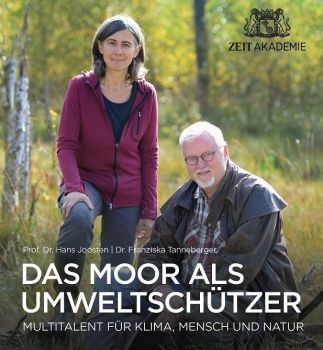
New: Online course by ZEITAkademie and GMC
8/12/2022 Peatlands as a multi-talent for climate, humans and nature – that seemed a sufficiently “burning” topic to ZEIT Akademie. In cooperation with the Greifswald Mire Centre th education provider produced an online course Peatlands as environmental protectors. It has four chapters and 74 minutes. Starring: Prof. Hans Joosten, scientist and one of the GMC’s founders, who has been awarded the German Environmental Prize in 2021 and the Federal Cross of Merit in 2022. He explains the basics on peatlands. Dr. Franziska Tanneberger describes why drained peatlands harm the climate and why we need peatland protection. The studied landscape ecologist and one of the two directors of the GMC is always in action for peatlands -from field work to world climate summits. Henning Voigt, an agricultural pioneer on peatland, takes the participants with him on his rewetted areas and tinkerer Torsten Galke invites to visit in the Paludiculture Tiny House. Dr. Johannes Merck of Michael Otto Environmental Foundation reports that even large companies do trecognise the economic potential in peatlands today. To develop a climate-friendly use of wet and rewetted areasareas is part of the toMOORow initiative, which promotes peatland rewetting as a nature-based solution to the climate crisis and species extinction, as well as an example of sustainable regional creation of added value through paludiculture.
According to its own information, ZEIT Akademie works with the best experts in their respective fields, such as the climate scientist Prof. Stefan Rahmstorf. An important argument for the two GMC scientists. "For today's challenges, science must not remain in the ivory tower. We want to teach peatlands in a non-university context as well." says Franziska Tanneberger "Of course, the quality must not be lost in and the subject must not suffer due to severe briefness. In this course, that can be combined." Another consideration: The ZEITAkademie's offerings are aimed at private individuals, but primarily at companies for in-house training. A good opportunity to foster a change in a wider public perception of peatlands - because peatlands are not scary, but incredibly important - for all of us.
by NK
Global Peatland Assessment
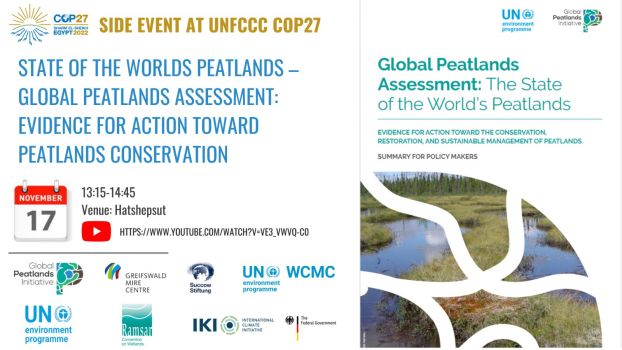
Thur 17th Nov at COP27/Sharm el-Sheikh
16/11/2022 A first comprehensive assessment of global peatlands will be presented in an official side event State of the Worlds Peatlands – Global Peatlands Assessment: Evidence for action toward peatlands conservation at the World Climate Summit COP27 at 17th November 2022 from 13:15-14:45 (GMT+2). The assessment includes an updated version of the Global Peatland Map compiled by the Greifswald Mire Centre (GMC) and provides latest science on peatland distribution, trends, and pressures. Most importantly, it recommends actions for the conservation, restoration, and sustainable management of peatlands, in particular for climate protection and adaptation to climate change.
At the side event, the GPA’s input information, spatial data generation, collation approaches, and the current gaps in coverage and resolution are presented in detail.
In a global context of the UNEA-4 Resolution on the “Conservation and Sustainable Management of Peatlands” the assessment might be a step towards a future Global Peatlands Inventory.
The side event is organised by Succow Foundation (MSF)/Greifswald Mire Centre (GMC) in cooperation with the United Nations Environmental Programme (UNEP), Global Peatlands Initiative (GPI) and UNEP-WCMC together with the Convention on Wetlands.
by RB
Many peatlands, but there's room for more
Action Programme for Natural Climate Protection
28/10/2022 Peatland protection as a nature-based solution for effective climate protection is extensively considered in the Action Programme Natural Climate Protection (ANK), states the Greifswald Mire Centre in contributing to the German Environmental Ministry's online dialogue on this programme. But there is still some room for improvement. Here is a summary of the most important points:
- The target of 5 million t CO2 eq. annual reduction from peatlands by 2030, which is also set in the Peatland Protection Strategy, is still too low. This is less than 10% of the current annual peatland emissions of 53 million t CO2.
- The framing should change. Germany's peatlands are currently predominantly (85%) used for agriculture or forestry. The term "renaturation" suggests a natural development unaffected by humans after rewetting and the possibility of returning the peatlands to their former condition. In Germany, neither of these is possible. Therefore, the terms "rewetting" and "restoration" are more appropriate. These formulations express that the ANK also includes new, sustainable uses for peatlands.
- The ANK can educate more people about peatlands and build long-term structures at federal, state and municipal level. In addition to voluntary measures, it should also make adjustments to planning and regulatory law, thus enabling common engagement of participating authorities at work level for a comprehensive landscape assessment.
by NK
MoorWissen revamped

Fresh colours, fresh information
24/10/2022
More MoorWissen and more beautiful - that's what our platform moorwissen.de now offers. We have thoroughly overhauled it, redesigned it and added new information. We want to offer appropriate information on peatlands and their importance for climate protection and biodiversity - ranging from small explanatory films to scientific studies - to people from laypersons to scientists.
The section MoorWissen Summary offers a quick start. Supplementary to the brief explanations, there is an info cluster each on peatland in research, in practice and in politics. Here and on other pages, tile elements enable users to navigate in addition to the drop down menu.
Detailed information can be found under Projects & best practise examples that the partners in the Greifswald Mire Center have carried out so far. Both can now be found in one overview. There is a total of 40 projects, most of them with a duration of several years - quite remarkable, in our opinion.
New is a section on Moorpädagogik (German only), dealing with the mediation of peatlands and climate protection pedagogically, and the section Moore & Kunst (German only). From experimenting with biomass from peatlands, to exhibitions, workshops, residencies, poetry and finally this year's Peatland Pavilion at the Venice Art Biennale - it's worth scrolling through these creative projects.
An entire section is dedicated to paludiculture, divided and assorted to paludiculture on bogs and fens. It also includes tools such as a climate protection calculator for drained areas.
Also, now on MoorWissen: an event calendar, our newsletter subscription and social media channels. But, there is one fly in the ointment, to be honest. There is still a lot do for presenting the entire page in English, but we are working on it. We are happy to receive feedback and other suggestions about our revamped MoorWissen-Webpage via email to communication@greifswaldmoor.de !
by NK
Duly awarded!
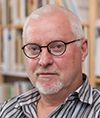
Federal Order of Merit for Hans Joosten
27/9/2022 Professor Hans Joosten from Greifswald will receive the Order of Merit of the Federal Republic of Germany on 30th September for his research on and his personal commitment to peatlands and climate protection. Matching the slogan "Building Bridges", Federal President Frank-Walter Steinmeier will honour the peatland scientist and further 20 persons on the occasion of the Day of German Unity at Bellevue Palace which is celebrated on the 3rd October. According to the Office of the Federal President, the eleven women and ten men are making an outstanding contribution to finding solutions to the global challenges of our time, such as the war against Ukraine, the Corona pandemic, poverty reduction, migration and climate change, as well as to strengthening cohesion in our country.
Regarding the award for the native Dutchman, it says: "Thanks to Hans Joosten, it is known today: drained peatlands are climate killers, "rewetted" ones are climate savers. The biologist is a pioneer in the search for ways to protect the climate. At the University of Greifswald, he co-founded the Greifswald Mire Centre, one of the world's most sought-after research centres for climate protection. However, Hans Joosten has not left it at scientific research on the relevance of peatlands for the climate. He has shown practical ways to use the areas for agriculture again and in the process coined a whole new discipline, "paludiculture". Beyond his scientific work, he has always been involved in political debates, because climate protection needs everyone's action."
Frank-Walter Steinmeier and Joosten had already met last year at an award ceremony. The Federal President had presented the scientist with the German Environmental Award 2021 of the Deutsche Bundesstiftung Umwelt (DBU).
by RB
"The Mouse" exploring peatland
About cow burps, smacking soil and sour cucumbers
17/8/2022 "The Mouse" was here! During this summer, the children's programme took a close look at climate issues – and among other places also in a peatland. The scientists of the Greifswald Mire Centre told “The Mouse” why peatlands are drained, peat is extracted and why farming on these soils is bad for the climate - especially when cows graze on them. Clarissa, Ralph and Johannes explain what pickled cucumbers and peatlands have in common, why a man on snowshoes is remote-controlling a "lawnmower" and why the ground is smacking. You may find the programme "Sendung mit der Maus" of Sunday 21 August in the ARD media library.
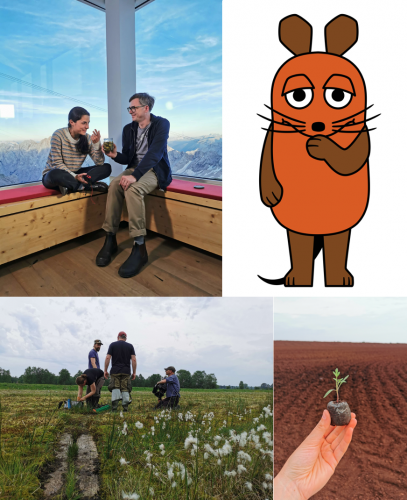
by RB
Summer … time for travels
Visiting: MEPs, MdBs, MdLs, Profs, CEOs...
1/9/2022 Summer time is... travel time... that was clearly to be noticed at the Greifswald Mire Centre. Numerous visitors almost turned the door handle one after another in July and August. Interest in peatlands is growing in politics, business and climate research, and we are happy to support it.
The youngest MEP Delara Burkhard (Progressive Alliance of Socialists & Democrats, S&D) and her colleague MEP Jutta Paulus (Die Grünen/EFA) asked at the GMC how peatland protection could be promoted at European level. Ricarda Lang, member of the Bundestag MdB (Federal Chairwoman of Bündnis 90/Die Grünen), stopped in the Hanseatic city during her summer trip to find out more about peatland research and innovative use and to discuss what federal politics could do for more climate protection through peatland protection. Her colleague in the Bundestag, Anna Kasautzki (SPD), was equally interested. As a MdB for the constituencies of Vorpommern-Rügen and Vorpommern-Greifswald, she is already familiar with the GMC and had herself updated on site. After a peatland excursion near Greifswald, the member of the state parliament (Mitglied des Landtages, MdL) Hannes Damm (Bündnis 90/Die Grünen MV) organized a public discussion in the city with the participation of the GMC on rewetted peatlands and their possible use. The Lower Saxony state parliamentary group from Bündnis 90/Die Grünen paid a visit with MdL Miriam Staudte to the test area for peat moss paludiculture near Oldenburg.
Climate researcher Prof. Stefan Rahmstorf of the Potsdam Institute for Climate Impact Research (PIK) has peat (German: Torf) in his name and mires in mind. During his visit to the GMC, he also found out how rewetting and paludiculture can help to combat the climate crisis.
Parallels of full-bodied drinks could be discovered during a visit from the Störtebeker Braumanufaktur. Peat and whisky seem almost old school as a pair now. Paludiculture and beer - this combination offers completely new possibilities, as it turned out in the conversation. Materials from paludiculture are also of interest in the textile industry. So the Scottish company Saltyco® contacted the GMC and came to visit. Reducing and replacing the use of peat in horticulture is a concern at Gramoflor. Here, too, there are promising approaches using paludiculture biomass, which were discussed together with the GMC.
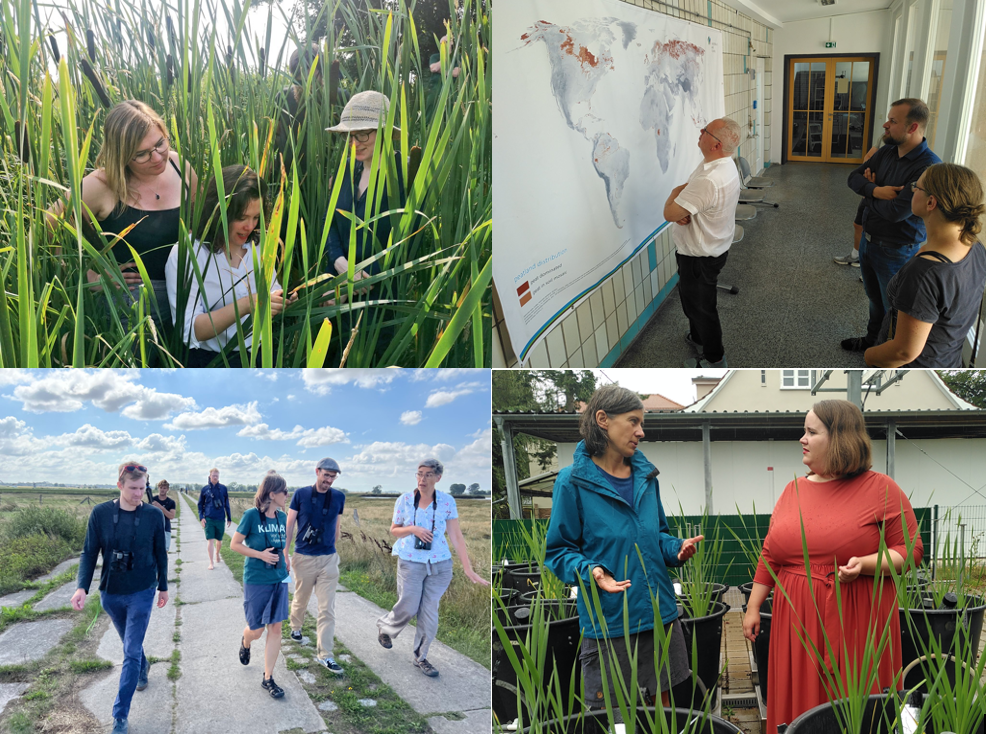
by RB
No more delay in EU restoration law
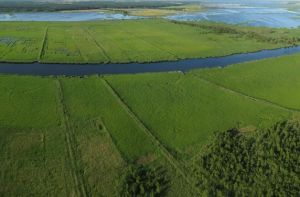
EU Nature Restoration Law must come now
9/6/2022 Nature-based climate protection through the restoration of ecosystems, for example peatlands, offers an outstanding opportunity to combat the unabatedly progressing climate and biodiversity crisis - and an opportunity that must not be squandered. However, the EU Commission has repeatedly postponed the binding EU Nature Restoration Law, which was actually planned for the end of 2021 - first to March 2022. Now it is to be published on 22nd June 2022. In an open letter to the Commission, a network of more than 60 organisations from environmental protection, nature conservation, science and agriculture, coordinated by the International Mire Conservation Group (IMCG), is therefore calling for a "law now". In the EU, however, more than 50% of peatlands are in poor condition, they release large amounts of greenhouse gases as well as nitrates due to drainage, and more and more peatland animals and plants are being lost due to habitat destruction. Rewetting peatlands just offers massive improvement - and in many cases these areas can still be used for agriculture and forestry! With paludiculture, i.e. "wet agriculture and forestry", which has recently also become part of European agricultural policy, value creation, bioeconomy and circular economy can be developed in peatland-rich rural areas. In order to draw attention to the great importance of peatlands and to emphasise the need for ambitious rewetting and restoration of peatlands in the new EU Nature Restoration Law - and not to remove them from it, as is feared - a broad network of more than 60 organisations from environmental protection, nature conservation, science and agriculture has today addressed an urgent appeal to the EU Commission. They demand to defend the success of the EU Green Deal in the EU Nature Restoration Act and to push for an ambitious policy for the rewetting of drained peatlands in Europe. To achieve the climate change targets of the Paris Agreement and the EU Climate Change Act, a transformation pathway for all peatlands in the EU should lead to net CO2 emissions by 2050. The EU should take the lead in the UN Decade for Ecosystem Restoration and achieve ambitious biodiversity targets at the upcoming Biodiversity Convention conference in Kunming, China.
by RB
The Venice Agreement
Peatland-art combo with political effect

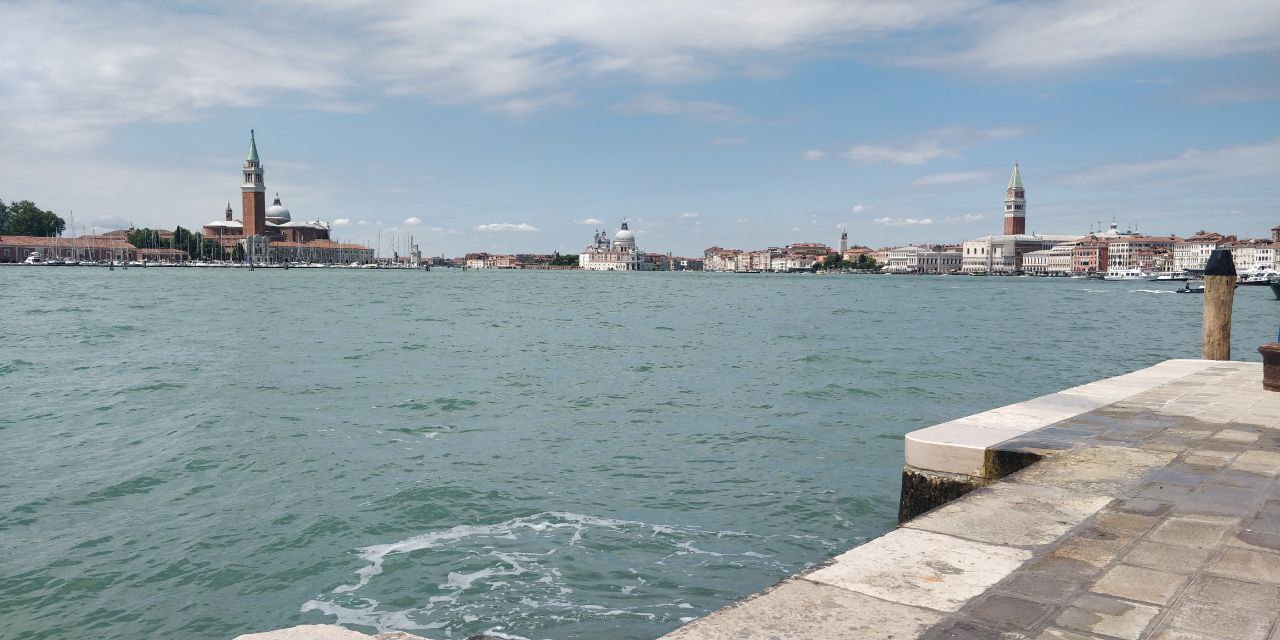
31/5/2022 Peatland and art are combined in an installation at this year's Venice Biennale. Artists and peatland scientists, including some of the Greifswald Mire Centre, have joined forces in a worldwide network. With an art installation and happening they want to achieve more for peatlands also politically. Representatives from art, science, nature conservation, climate policy and indigenous peoples announced the Venice Agreement at the 59th Art Biennale in the lagoon city on World Peatland Day, 2nd June 2022. Following the term “Paris Agreement on climate protection”, the Venice Agreement shall point out, that the preservation and restoration of peatlands is crucial for climate and people on our planet. It was signed, among others, by the Greifswald peatland scientist Prof. Hans Joosten, winner of the German Environmental Award. The agreement is part of the art initiative Turba Tol Hol-Hol Tol an its peat moss installation in the Chilean Pavilion at this year's Biennale. There, the international artist collective Ensayos has set up a peat moss lawn with a video installation for this purpose in one of the historic Venetian warehouse buildings. A fair share of support was given by the Greifswald Mire Centre and the company Moorkultur Ramsloh, which harvested the peat mosses on their research sites in Lower Saxony, Germany, and organised delivery to Venice. The pavillon’s visitors can now discover the peat mosses and the moist oscillating surface they form with all senses. The video sequences convey the fascination of the peatlands in sound and vision. Turba Tol Hol-Hol Tol is primarily dedicated to the peatlands of Patagonia and the indigenous population there. At the same time, it shows that the preservation of nature, including the peatlands, is in the interest of all present and future societies and that the destruction of nature to date can only be reversed globally through the joint efforts of many local initiatives
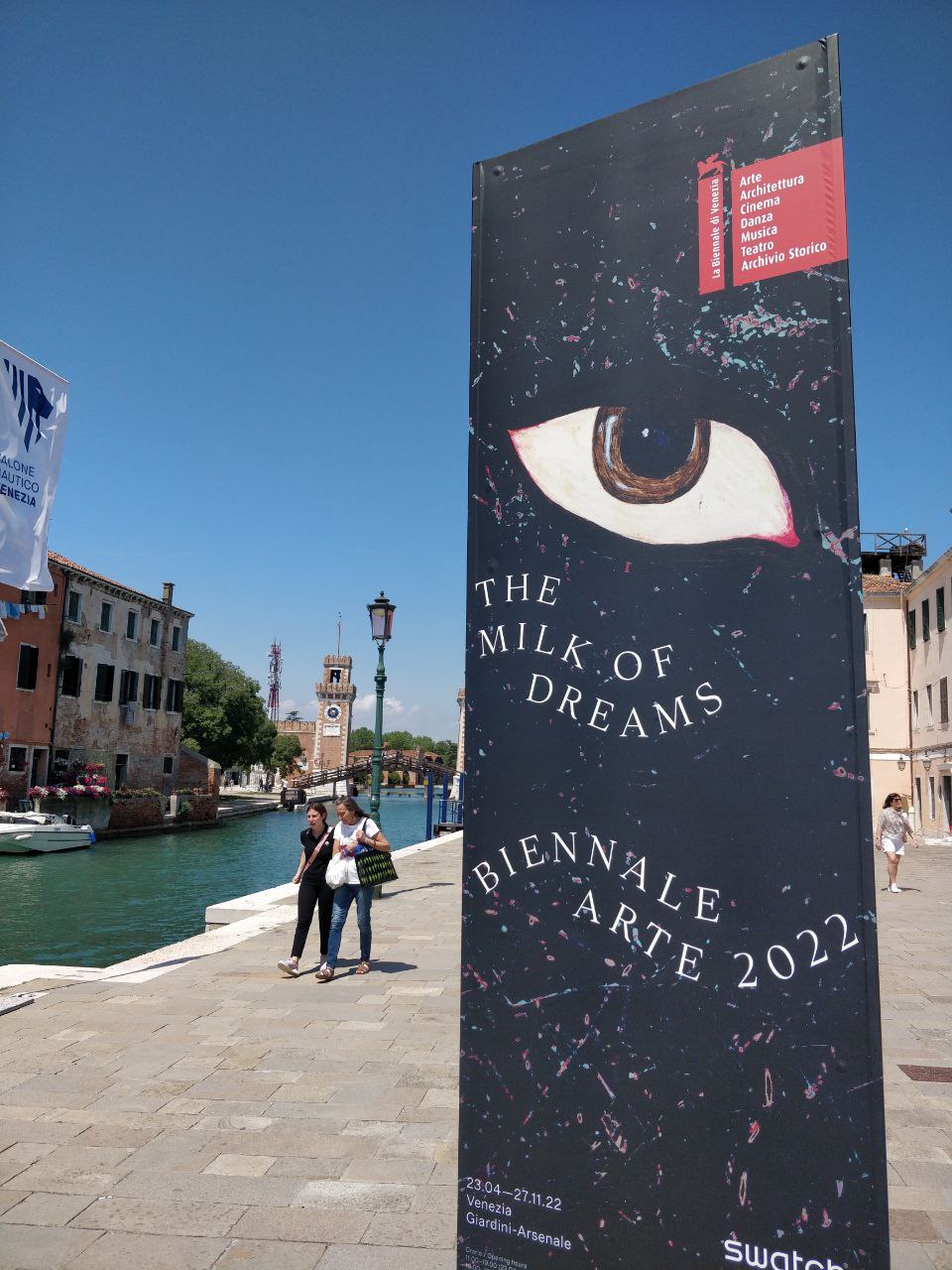
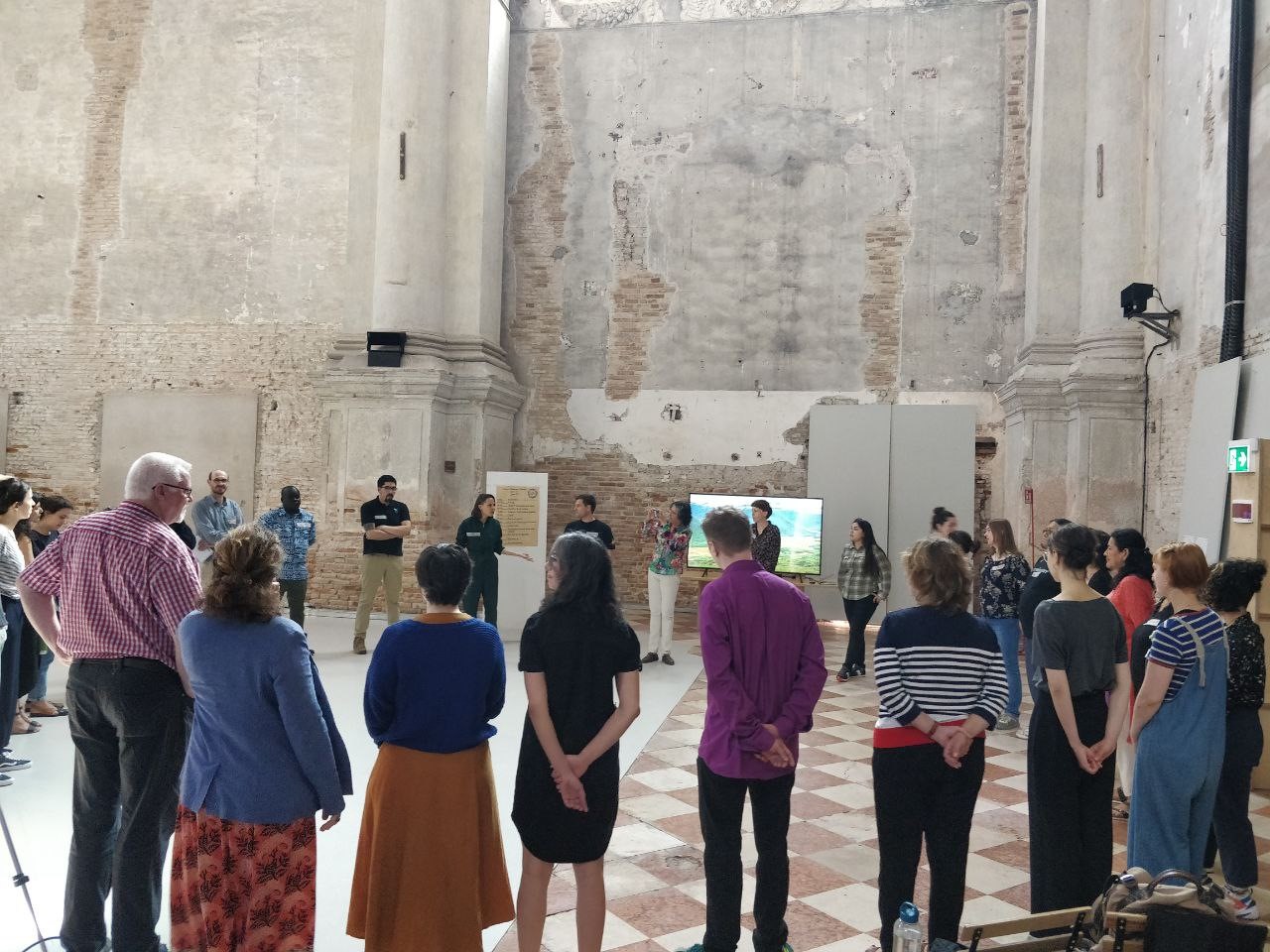

by NK
Peatland plants are the best CO2 reservoirs
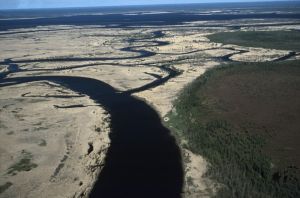
New paper in Science
6/5/2022 Wetlands such as peatlands, salt marshes, mangrove forests and seagrass beds store about five times more carbon per square metre than forests and 500 times more than oceans, an international team including Greifswald peatland scientist Prof. Dr. Hans Joosten has now shown in a recent article Recovering wetland biogeomorphic feedbacks to restore the world's biotic carbon hotspots in the renowned academic journal Science. The reason: In wet ecosystems, plant growth and carbon deposition in the soil stimulate each other. The paper, co-authored by scientists of the Netherlands Institute of Oceanography (NIOZ), Utrecht University, Radboud University Nijmegen, the University of Groningen and the University of Greifswald, also contains good news: protection and restoration of such wetlands can help humans to reduce the CO2 concentration in the atmosphere in view of the climate crisis. And - we are getting better at managing and restoring these ecosystems.
by RB
Jung&Naiv on peatlands&climate
Live on YouTube on May 6th
5/5/2022 Naive questions about peatlands and climate Tilo Jung of Jung & Naiv will ask Dr. Franziska Tanneberger of the Greifswald Mire Centre tomorrow live on YouTube. Tune in starting at 5 p.m.. Jung&Naiv is already collecting input and questions on twitter @TiloJung and @JungNaiv.
by RB
Photovoltaics on peatland
Yes, and only if... says new info paper
8/4/2022 Photovoltaic systems are already being built on peatlands – but on drained peatlands that are strong sources of CO₂. There are hardly any legal requirements for this so far. Photovoltaic plants on rewetted peatlands could provide a "collateral benefit," said Bernhard Krüsken, secretary general of the German Farmers' Association, at the conference "Peatland Protection is Climate Protection" in Berlin on 28th March 2022. The Greifswald Mire Centre had already worked on this preliminarily in a new information paper. The combination of photovoltaic systems and peatland rewetting would be able to replace fossil fuels and reduce CO₂ emissions at the same time. However, there is still a great need for testing and development. Therefore, the GMC recommends an area limitation for the time being and has compiled hints for a sustainable implementation.
by RB
What must happen now on peatlands!
Conference "Peatland Protection is Climate Protection"
29/3/2022 Wet peatlands are natural climate protection! That’s what scientists of the Greifswald Mire Centre together with practitioners and partners clearly stated at yesterday's conference "Peatland Protection is Climate Protection" in front of 200 participants in Berlin and just as many viewers in the livestream. Up to seven percent of Germany's greenhouse gas emissions can be saved by rewetting drained peatlands. It therefore represents one of the most effective measures for the "Natural Climate Protection" action programme announced today by Steffi Lemke, Federal Minister for the Environment, Nature Conservation, Nuclear Safety and Consumer Protection.
"More crises must not be allowed to accumulate. Wet peatlands are natural climate protection and therefore rewetting is one of the most effective measures for it in Germany. That is why they play an important role in the new action programme budgeted at 4 billion Euros," said Federal Minister Lemke at the conference.
The expertise exists. Scientists of the Greifswald Mire Centre and partners have researched the climate impact of wetlands and tested paludiculture together with farmers. Innovative entrepreneurs have developed regional and ecological products from it. Individual German states have issued carbon certificates from rewetting. Now it is a matter of implementing climate protection through peatland conservation large scale, as the conference showed. Representatives from nature conservation, agriculture and companies agree that political, administrative and financial framework conditions still need to be created.
Prof. Dr. Kai Niebert, President of the German Nature Conservation Circle, described the rewetting of peatlands as a task for society as a whole, similar in dimension to the coal phase-out. In terms of climate protection, the clock showed five to twelve, while in terms of biodiversity it has already run out, he stated. If we still wanted to ensure food security, we now had to think differently and had no choice when it comes to peatland protection, Niebert said. This now be driven forward decisively and jointly.
Bernhard Krüsken, Secretary General of the German Farmers' Association, considered the rewetting of peatlands to be a generational project, just as drainage had been. He thought it important to involve everyone, to communicate honestly about the scope of the measures and to promote them in the long term. Land users must be offered alternatives and Paludi-PV, i.e. photovoltaics on rewetted moorland, could be a 'collateral benefit', Krüsken said.

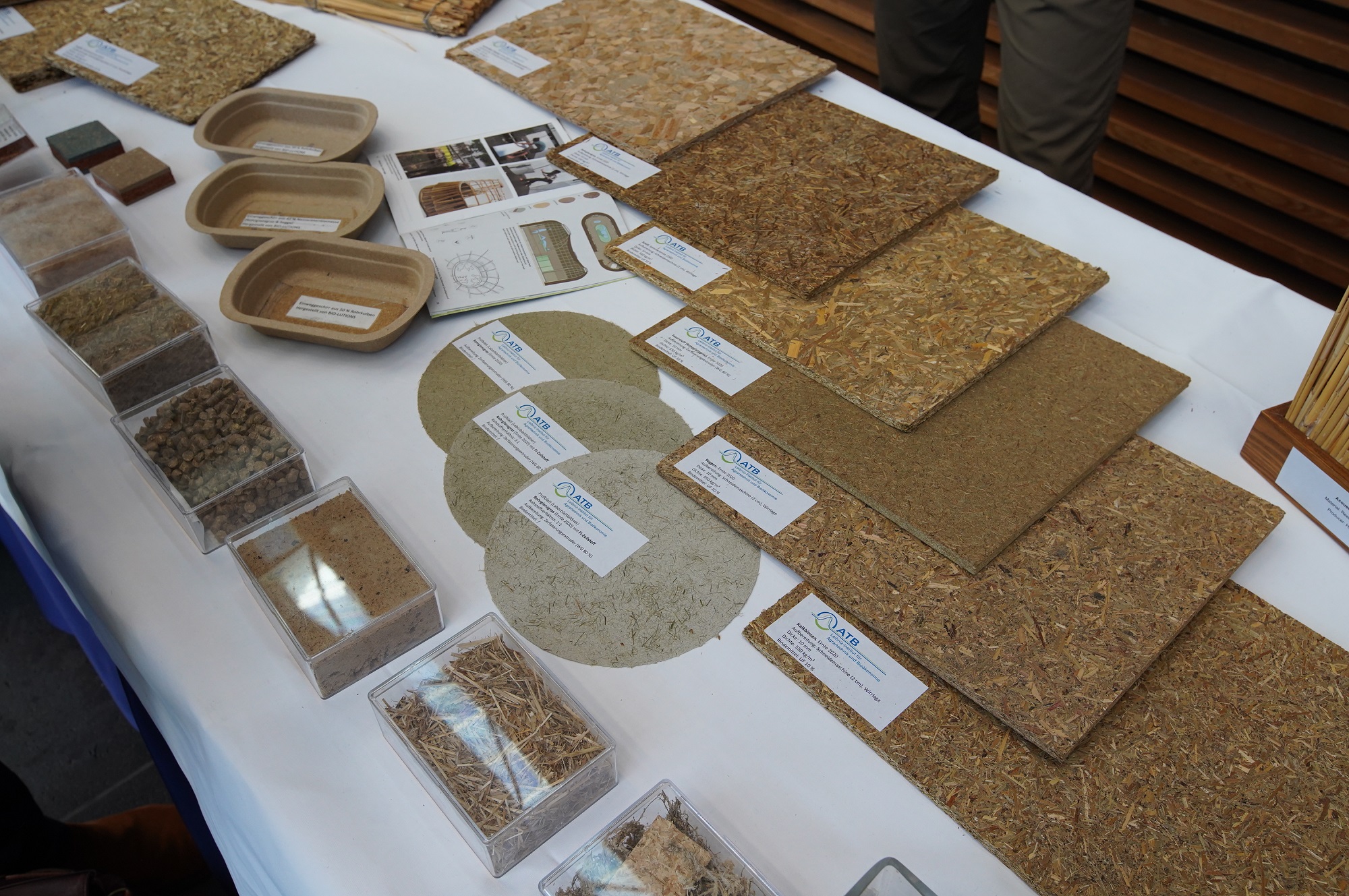

by RB
Save the Date: "Peatland Protection is Climate Protection" 28 March 2022 / Berlin
For the 2030 climate goals: What must happen on peatlands now
29/3/2022 The Greifswald Mire Centre (GMC) and the German Association for Landscape Conservation (DVL) cordially invite you to the conference “Peatland Protection is Climate Protection on 28 March 2022 in Berlin.
By 2030, annual greenhouse gas emissions from peatland soils are to be reduced by five million tonnes of CO₂ equivalents. But how can this be achieved?
Rewetting has been proven to be a key measure to reduce the high GHG emissions from peatlands. Wet use appropriate to the site(paludiculture) offers a way to continue management. This will be discussed by scientists, practitioners and politicians, including Steffi Lemke, Federal Minister for the Environment, Nature Conservation, Nuclear Safety and Consumer Protection (BMUV) and Cem Özdemir, Federal Minister of Food and Agriculture (BMEL, requested).
The joint project "MoKli - Realising peatland and climate protection with land users" by GMC and DVL would like to present a variety of approaches to solutions at the conference using practical examples. The programme also includes discussions on how these can be applied on a large scale, accelerated and practice-oriented in the coming years as part of climate protection strategies at different levels.
The conference is aimed at parliamentarians, representatives of ministries and authorities at federal, state and local level, representatives of associations from agriculture and water management, climate protection and nature conservation as well as other decision-makers. The event is free of charge, registration is possible online at www.mokli.de.

by RB
Accelerated Peatland Protection in Lower Saxony
The GMC supports the motion of B90/The Greens
15/3/2022 The GMC supports the motion of B90/Greens Yesterday, the Greifswald Mire Centre and other experts were invited to a hearing in the Environment Committee of the Lower Saxony Parliament to comment on the motion of the Bündnis 90/ Die Grünen parliamentary group "Peatland protection = species protection + climate protection" (Drs. 18/10170). Since Lower Saxony owns about 670,000 hectares of organic soils and is thus the German federal state richest in peatlands. The peatlands are predominantly used agriculturally, especially as grassland, and drained for this purpose. These areas thus cause high greenhouse gas emissions, which makes Lower Saxony frontrunner in terms of greenhouse gas emissions from organic soils among the federal states. Only rewetting can stopp these emissions. In the past 40 years, an average of 950 hectares of peatland per year have been rewetted, and the GMC calculates that 20,000 hectares per year need to be rewetted in order to achieve the Paris climate protection targets. In the GMC’s statement supports the motion of Bündnis 90/ Die Grünen in many points and explains further ones in order to substantially accelerate the peatland protection in Lower Saxony
by RB
Also via livestream
Conference "Peatland Protection is Climate Protection" 28 March 2022
15/3/2022 Due to the high number of registrations, the Greifswald Mire Centre now also offers a livestream of the conference "Peatland Protection is Climate Protection” on 28 March 2022 in Berlin starting at 10 a.m.. How can annual greenhouse gas emissions from peatland soils be reduced by five million tonnes of CO2 equivalents by 2030? Scientists, farmers, practitioners and politicians, including Steffi Lemke, the German Federal Minister for the Environment, Nature Conservation, Nuclear Safety and Consumer Protection, will discuss this at the conference. The conference is aimed at parliamentarians, representatives of ministries and authorities from federal, state and local governments, representatives of associations from agriculture and water management, climate protection and nature conservation, as well as further decision-makers.
by RB
3 kg, 544 pages - Germany's peatlands
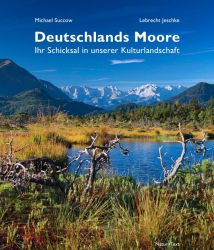
Book launch 28th March in Berlin
3/3/2022 At 3 kg, the recently published book “Moore in Deutschland” is not only a heavyweight on the scale, but also in terms of content. It presents Germany's 115 most important peatlands on 544 pages and with 908 photographs. On Monday 28th March, the authors Prof. em. Dr. Michael Succow and Dr. Lebrecht Jeschke will present the book at 7 p.m. at the Mecklenburg-Western Pomerania State Representation in Berlin. During the moderated discussion, co-authors Dr. Franziska Tanneberger and Dr. Greta Gaudig will also discuss the importance of peatlands for climate protection on the panel. During the day the conference “Peatland Protection is Climate Protection” is entirely dedicated to the same topic from 10 a.m. - 5 p.m. at the State Representation of Lower Saxony in Berlin, which will also be offered via livestream.
by RB
250 boxes of sphagnum mosses for Venice
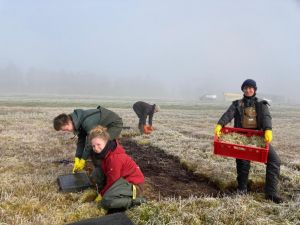
Pavilion on peat moss at the Biennale
3/3/2022 A pavilion with a peat moss installation is to be erected at this year's Venice Biennale. With the project named TURBA TOL - HOL HOL TOL the artist collective ENSAYOS and scientists from the Greifswald Mire Centre want to draw attention to the importance of peatlands for mankind. They are getting 250 boxes with the delicate plants underway. They will harvest the peat mosses by hand from 2nd-4th March on a cultivation and research area in the Hankhauser Moor in Lower Saxony. These will fill Chile's Biennale pavilion. There, especially in Patagonia, huge areas of previously intact raised bogs need to be protected from mining and infrastructure projects. Peat moss experts of Greifswald University and the peat plant Moorkultur Rahmsloh can provide these plants, which are strongly threatened and protected in natural habitats. Since 2004, both institutions have been conducting joint research on peat mosses. They installed an experimental area for the cultivation of peat mosses near Rastede in Lower Saxony, which today covers 17 ha. On Thursday and Friday 3rd-4th March, the scientists plan to harvest 250 boxes of peat mosses there together with the New York artist Christy Gast. A small art act to follow: The sphagnum mosses must arrive in Venice undamaged by 15th March! The Biennale itself begins on 23rd April and runs until 27th November this year. Half a million visitors are expected there. During this time, the mosses will live and grow as if in an artificial bog. A specially installed system will monitor and display the growth parameters of the peat moss carpet. It informs visitors on the carbon accumulated and the water needed. In order to acquire the necessary knowledge on peatland and climate issues for the installation of the pavilion, artist Gast is currently spending a residency in Greifswald. The city surrounded by peatland offers scientific expertise of the Greifswald Moor Centrum and, as the birthplace of Caspar David Friedrich, also a proud artistic heritage. The residency is funded by the Federal Government Commissioner for Culture and the Media and the Municipal Office for Education, Culture and Sport of the University and Hanseatic City of Greifswald.
by RB
To be improved significantly
Better protection of natural carbon stocks in the EU
20/2/2022 Twenty environmental organisations under the umbrella of the German Nature Conservation Ring (DNR), including the Succow Foundation, partner in the Greifswald Mire Centre, demand a better protection of natural carbon reservoirs and sinks - including peatlands - and to develop them in harmony with species and nature conservation. The critique is addressed to the Parliament and Council of the European Union. So far, the draft of the new Land Use, Land-Use Change and Forestry (LULUCF) Regulation must be tightened up. Otherwise, the goal of climate neutrality at EU level by 2050 and at national level by 2045 at the latest cannot be achieved, the organisations stress.
They propose, among other things, to at least double the estimated target of storing 310 million tonnes of climate-damaging greenhouse gas emissions by natural sinks.
Since sinks must sequester more carbon than sources release by 2035, reducing emissions from land use must also be an equivalent target, for example stopping peatland drainage and amplifying rewetting. The LULUCF Regulation must include the reporting of requirements for categories for forests, arable land, grassland and wetlands so that measures can be assessed and adjusted.
The EU Commission had presented its proposals for the amended LULUCF Regulation in mid-July this year as part of the "Fit for 55" climate package. This is intended to adapt the existing legislation to the new climate targets for 2030 and 2050. Now the EU Parliament and Council have to find and negotiate their positions in order to then bring about a legally binding decision. The Succow Foundation as a partner in the Greifswald Mire Centre, together with many other organisations, will continue to campaign for ambitious and comprehensive targets.
by RB
New publication
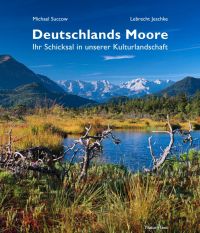
Book "Deutschlands Moore"
24/1/2022 The book "Deutschlands Moore - Ihr Schicksal in unserer Kulturlandschaft" by Prof. em. Dr. Michael Succow, founder of the Succow Foundation, and Dr. Lebrecht Jeschke, published by Natur&Text, has just been printed. On 544 pages, it depicts the diversity of the country's mire landscapes - 115 locations from the salt marshes on the coast, the rain marshes of north-west Germany and the river valley marshes in the southern Baltic Sea region to the mires of the low mountain ranges, the Alpine foothills and the Alpine fringe. The book presents near-natural as well as degraded peatlands in all parts of Germany. In addition to the 908 photos, numerous tables, graphics, information boxes and maps make the complicated relationships understandable. Dr Greta Gaudig and Dr Franziska Tanneberger, director of the Greifswald Mire Centre, provide an outlook on the future of peatlands, their rewetting and sustainable use.
by RB
On International Wetlands Day 2.2.2022
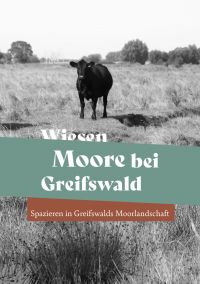
The bog side of Greifswald
27/1/2022 Salt pan, coal ditch, swinging soil and peat in your teeth - for the International Wetlands Day on 2 February, people at Greifswald can get to know the bog side of the city on their own. The new brochure “Peatlands near Greifswald” by the Greifswald Mire Centre and the University and Hanseatic City of Greifswald offers two tours through this landscape, which is (mostly) not scary, but incredibly important for climate protection on our doorstep and worldwide. On a free guided tour starting at 4 p.m. in the Steinbecker Vorstadt polder peatland specialist Christina Lechtape and the municipal peatland manager Annie Wojatschke will explain why. The meeting point is the "An der Bleiche" pumping station near the harbour bridge. The brochure "Peatlands near Greifswald" is available as a download or for a nominal fee of one euro at the city information office, the city library and the Greifswald bookshops.
In the urban area of Greifswald there are approx. 472 ha of peatlands, which are mainly drained and cause approx. 7,600 t CO2-eq. per year. An enormous burden for the city's climate balance, but at the same time a great potential for reducing emissions. Greifswald has recognised this and last October hired Germany's first municipal peatland manager. That way, local peatlands can be revitalised with further positive effects for the surrounding area.
The 2nd February 2022 is not a date to be taken lightly - on the contrary: This year, World Wetlands Day (WWD) will be celebrated for the first time as an international day recognised by the United Nations. Since 1997, it has drawn attention to the importance of wetlands, including peatlands, every year on 2nd February. Back then in 1971 the Ramsar Convention was adopted, it is the international agreement to protect wetlands. However, since then, 35% of wetlands have been further destroyed by pollution, agriculture, overfishing, among other things. Wetlands are disappearing three times faster than forests. Conservation and restoration actions urgently need to make up for the loss. "Wetlands Action for People and Nature" is therefore the motto of this year's WWD.

by NK
In the Nile catchment - peatlands?
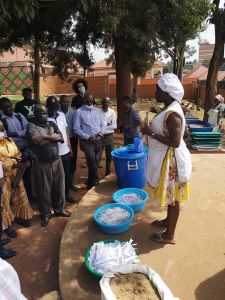
Conference of the Nile Basin Initiative with GMC
24/1/2022 The Nile Basin Initiative organized a 3-day conference on peatlands in the Nile catchment area from January 19th - 21st January in Kampala with the support of the Gesellschaft für Internationale Zusammenarbeit (GIZ) and the Succow Foundation. The conference drew attention to the fact that the Nile and its outflow are strongly influenced by the water regulation of tropical peatlands in the upper catchment area on the Great Lakes in East Africa. It also made aware of these areas as vast carbon stores.
In an study on local peatland distribution in 2019 the Greifswald Mire Centre could show how much carbon these peatlands potentially store and could thus arouse the interest of the countries bordering the river. Thereupon, government and civil society representatives from Tanzania, Burundi, Rwanda, Uganda and South Sudan attended the conference. They now have a better understanding of where to find peatlands and how they work. The topics included a climate-friendly management of peatlands and value chains for products from wet peatlands. Papyrus, a widespread peatland plant, is traditionally harvested along the Nile and its high-quality fibers are processed. Given the growing population, this form of paludiculture is not sufficient for a livelihood of many. To ensure no further areas are drained, use in paludiculture must be further developed. With the conference closing the governments of the region widely agreed on this. The Succow Foundation is already working with partners and entrepreneurs in the DIAPOL-CE project on creative ideas for this.
by Dorothee Scheuch
New meat atlas takes a look at the peatlands
Why “moor milk” is bad for the climate
7/1/2022 The CO2 footprint of one liter of “moor milk”, whether organic or not, is five times higher than that of milk from other pastures – how does that work? Sabine Wichmann (GMC) explains the invisible climate damage from the connection between animal husbandry, food production and soil in the current meat atlas: Drained moorland and used for agriculture release the carbon that is preserved when wet into the atmosphere as CO2. These emissions cause high levels of climate damage and are part of the carbon footprint of food. However, this is not yet apparent to consumers - labeling would help here. In Germany, these peatlands make up only seven percent of agricultural land, but their drainage is responsible for 37 percent of greenhouse gas emissions from agriculture and agricultural land use. The situation is similar across the EU.
